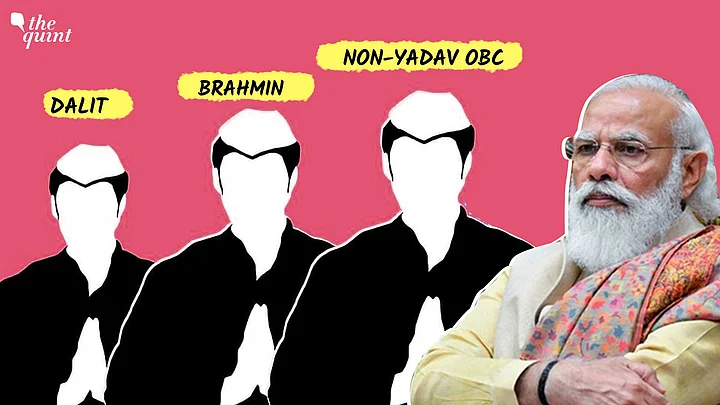Prime Minister Narendra Modi has given shape to his new cabinet.
In a major reshuffle, 12 ministers were axed while 36 new faces were inducted. 7 Ministers of State-rank were elevated to Cabinet minister rank.
A lot of emphasis has been placed on social engineering in the cabinet, after all caste plays a key role in determining voter behavior in elections in India. 47 ministers belong to the other backward classes, scheduled caste, and tribes, their highest ever representation.
BJP has moved a long way from being an upper-caste-dominated party under Atal Bihari Vajpayee to becoming the voice of the backward and Dalits under Modi.
Special attention has been paid to states where elections are due next year. 7 ministers from UP, 6 from Gujarat, 1 each from Uttarakhand and Manipur have been inducted. 1 minister (Anurag Thakur) from Himachal has been promoted.
Specific Communities From Uttar Pradesh Find Space
Leaders from UP have been inducted into the cabinet with a clear focus to win over the targeted constituencies of Non-Yadav OBC (NYOBC), Brahmins, and Non-Jatav Dalits in the 2022 Assembly polls. These include:
Anupriya Patel (Kurmi - NYOBC),
Kaushal Kishor (Pasi - non Jatav),
S.P.S Baghel (Gaderia-Dhangar - SC),
Pankaj Chaudhary (Kurmi - NYOBC),
Bhanu Pratap Singh Verma (Kori - NYOBC),
B.L. Verma (Lodh - NYOBC) and
Ajay Mishra (Brahmin).
Brahmins have reportedly been unhappy with the prominence of Thakurs under the Yogi administration. While two ministers from the Kurmi community were added, Santosh Gangwar, a veteran hailing from the community handed in his resignation.
BJP, through this rejig, has attempted to give a positive signal to its anchor voting blocks of NYOBC, upper caste, and non-Jatavs. It hopes this representation will reap rich dividends in the elections next year.
Communities in India crave political representation, to get a slice of the power pie, which ensures their demands are met and interests protected. Cabinet inclusions show that the party respects leaders from their caste.
Does just inducting a minister from a particular caste/group/community or providing mere representation fetch votes for political parties? Let’s try to analyse.
PM Modi’s First Reshuffle Helped BJP Win In UP
In Modi 1.O, the first cabinet reshuffle took place in July 2016. Of the various ministers inducted, 3 belonged to UP, where polls were due in six months in February 2017. Krishna Raj (SC), Anupriya Patel (Kurmi - NYOBC), and Mahendra Nath Pandey (Brahmin) were made ministers.
BJP went on to win big in UP, bagging more than 320 seats. An analysis of the voting pattern of these three communities shows:
● Party support among Brahmins increased by 24% from 38% in 2012 to 62% in 2017.
● Party’s support among the Non-Yadav OBCs (Kurmis not available separately) increased by 41% from 17% in 2012 to 58% in 2017.
●Party support among Dalits increased by 12% from 5% in 2012 to 17% in 2017.
A comparison with the 2014 general elections shows that the party had already secured significant support from these communities before the 2017 polls.
It lost marginal support amongst general caste and NYOBC voters and gained marginally among Dalits compared to 2014.
Even though the two elections are not strictly comparable, this fact cannot be ignored as BJP’s overall vote share was largely the same and the Modi factor worked in both the 2014 and 2017 elections.
BJP Made Electoral Gains After 2017 Reshuffle As Well
Now let’s move to the cabinet reshuffle carried out by Modi in September 2017, a year and a half before the 2019 general elections. Two MPs from UP, Satyapal Singh (Jat) and Shiv Pratap Shukla (Brahmin) were inducted as ministers,
BJP went on to retain the majority of the seats it had won in 2014 (64 versus 73 seats) despite a formidable Mahagathbandhan formed by Akhilesh Yadav’s SP, Mayawati’s BSP, and Ajit Singh’s RLD. An analysis of the voting pattern of these communities shows:
● Party’s support among the Brahmins increased by 5% from 72% in 2014 to 77% in 2019.
● Party’s support among the Non-Yadav OBCs increased by 16% from 60% in 2014 to 76% in 2019.
● Party’s support among the Jatavs increased by 6% from 15% in 2014 to 21% in 2019.
● Party support among the non-Jatavs increased by 15% from 45% in 2014 to 60% in 2019.
● Party’s support among the Jats declined by 20% from 77% in 2014 to 57% in 2019.
Here, we see that BJP benefitted in UP from cabinet expansions in 2016 and 2017 where members of its key support groups were given representation. These groups consolidated further behind the BJP as seen from the table below, except amongst Jats.
The caste-wise breakup of the vote share of BJP for the two elections also shows that party benefitted by making these appointments.
Caste Representation Alone Not Enough For Vote Gain
The above analysis shows that BJP did benefit electorally in UP by inducting ministers from its core support blocks/caste groups in cabinet reshuffle during Modi 1.O. The representation has a high symbolic value in caste-dominated society like UP. Will this trend continue, remains to be seen?
However, a word of caution, the increase in support for the party from a particular caste cannot be entirely attributed to such representation. Other qualitative factors may have also been at play, for example, counter polarisation in UP in 2019 due to BSP-SP-RLD forming an opportunistic alliance.
To sum up, further research needs to be carried out for other states to conclusively prove the theory that representation in cabinet reshuffles before major polls fetches votes and helps win elections.
(The author is an independent political commentator and can be reached at @politicalbaaba. This is an opinion piece. The views expressed above are the author’s own. The Quint neither endorses nor is responsible for them.)
